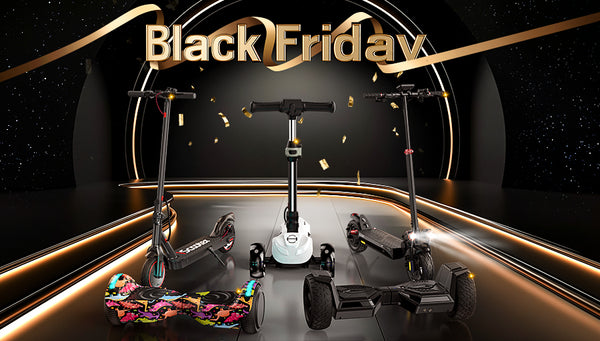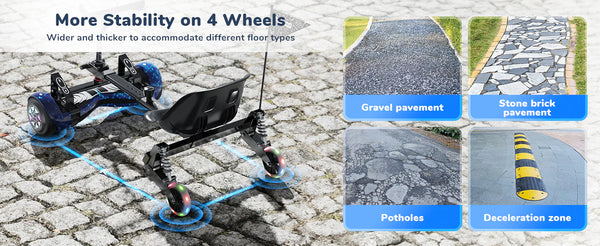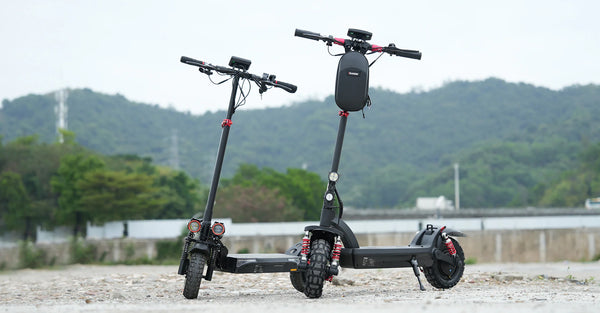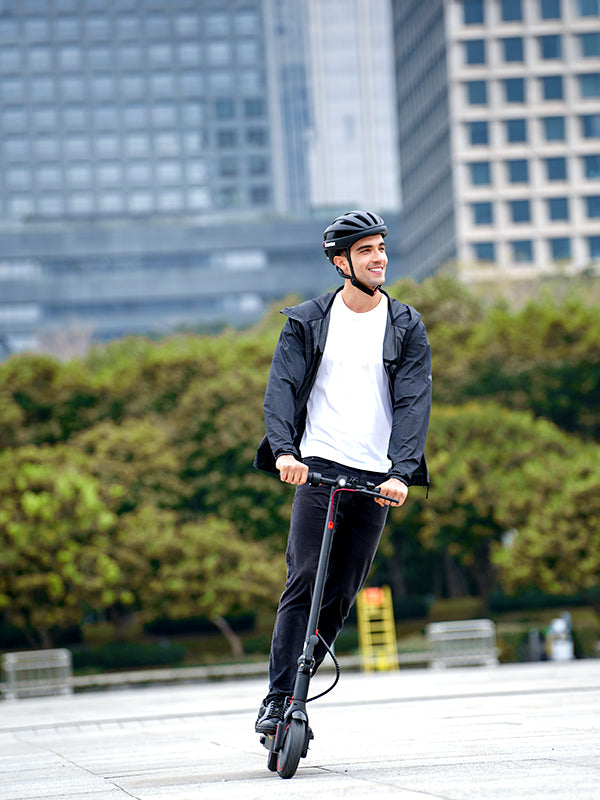
What is a Hoverboard?
Hoverboards, also known as self-balancing scooters, are two-wheeled, battery-powered devices that became popular in the early 2010s. They are called "hoverboards" because they give the illusion of floating or hovering when in use, although they actually have wheels that touch the ground.
The Origin of Hoverboard
The concept of a "hoverboard" has been around for quite some time, especially popularized by science fiction movies and shows like "Back to the Future." But how does it goes with it?
The relationship between hoverboards and the movie "Back to the Future" is a fascinating example of science fiction inspiring real-world technology and popular culture. In the "Back to the Future" film series, particularly in "Back to the Future Part II" released in 1989, a fictional hoverboard was prominently featured as a futuristic mode of transportation.
The hoverboard depicted in the movie was a levitating skateboard-like device that allowed characters to glide effortlessly above the ground. The portrayal of hoverboards in the film captured the imagination of audiences and became an iconic symbol of futuristic technology. The idea of a hoverboard that defied gravity and floated seamlessly resonated with viewers and sparked interest in the concept of a real-world equivalent.
Decades after the release of "Back to the Future Part II," the modern self-balancing scooter that gained popularity in the early 2010s was often colloquially referred to as a hoverboard. While the real-world hoverboards do not actually hover like their cinematic counterparts, they share similarities in terms of providing a novel and futuristic mode of personal transportation. The association between the movie and the real-world hoverboards has not only contributed to the devices' popularity but also underscores the enduring impact of science fiction on technology and culture.
The Design of a Hoverboard
The design of a hoverboard, is relatively simple yet innovative. Some details on the design aspects of a typical hoverboard are as follows:

Image: Internal structure and parts of Hoverboard
Platform: The main body of a hoverboard consists of a flat platform with two wheels on either side. The platform is where the rider stands while using the device. It is usually made of sturdy materials like ABS plastic or aluminum alloy to support the weight of the rider and the internal components.
Wheels: A hoverboard typically has two wheels—one on the left side and one on the right side. These wheels are usually solid rubber tires that provide traction and stability. The size of the wheels can vary, with some models designed for smoother surfaces and others for off-road terrain.
Internal Components:
- Battery: The battery pack is a crucial component of a hoverboard, providing the power needed for propulsion. Lithium-ion batteries are commonly used due to their energy density and rechargeability.
- Motors: Each wheel is powered by an electric motor that enables movement. These motors are controlled independently to allow for turning and balancing.
- Sensors: Hoverboards are equipped with gyroscopic sensors that detect the rider's balance and movements. These sensors help the device maintain equilibrium and respond to the rider's shifts in weight.
- Control Unit: A control unit processes the data from the sensors and adjusts the speed and direction of the motors to keep the hoverboard balanced.
Foot Pads: The foot pads on the platform of the hoverboard provide a non-slip surface for the rider's feet. The foot pads are often equipped with pressure sensors that detect the rider's foot movements and weight shifts, which are crucial for controlling the device.
LED Lights: Many hoverboards feature LED lights on the front, back, or sides for visibility and aesthetics. These lights can serve as indicators of the device's status and can enhance the rider's visibility in low-light conditions.
Charging Port: Typically, a hoverboard has a charging port located on the body of the device for recharging the battery. The charging port is often covered by a rubber flap to protect it from dust and water.
Design Variations: Hoverboards come in various colors and designs to cater to different preferences. Some models may have additional features like Bluetooth connectivity for playing music through built-in speakers, remote controls, or mobile app integration for customization and tracking.
The design of a hoverboard combines elements of simplicity, functionality, and technology to create a fun and convenient mode of personal transportation.
How Does the Hoverboard Work?
These devices rely on a combination of sensors, microprocessors, electric motors, and gyroscopes to maintain balance and facilitate movement. Here's how a hoverboard typically works:
- Platform and Wheels: A hoverboard consists of a platform with two wheels on either side. The wheels are independently powered by electric motors.
- Sensors: Built-in gyroscopic sensors detect the tilt of the hoverboard in various directions. These sensors continuously monitor the board's position and orientation.
- Microprocessors: The sensor data is processed by microprocessors on the hoverboard. The microprocessors interpret the data and determine how to adjust the speed and direction of each individual wheel to maintain balance.
- Balancing Act: When a rider stands on the hoverboard, the sensors detect any shifts in the rider's center of gravity. If the rider leans forward, backward, or to the sides, the sensors send signals to the microprocessors to adjust the speed of the wheels accordingly to keep the board balanced.
- Control Mechanism: The rider controls the hoverboard's movement by shifting their weight. Leaning forward causes the hoverboard to move forward, while leaning back makes it move backward. By leaning to the left or right, the rider can turn in those directions.
- Battery and Motors: The hoverboard is powered by a rechargeable lithium-ion battery. The electric motors in the wheels propel the device forward or backward based on the signals received from the microprocessors.
- Safety Features: Modern hoverboards often come with safety features such as speed limiting modes, low-battery indicators, and non-slip foot pads to enhance user safety.
The principle behind a hoverboard's operation is to maintain balance through real-time adjustments in wheel speed based on the rider's movements. By continuously monitoring the rider's position and making rapid corrections, the hoverboard can provide a smooth and intuitive riding experience.
Examples of Hoverboard in iHoverboard
H1 Navy Blue 6.5-inch Self-Balancing Hoverboard

The iHoverboard H1 Navy Blue 6.5-inch Self-Balancing Hoverboard is a cutting-edge personal mobility device designed for fun and convenient transportation. With its striking Navy Blue color and advanced self-balancing technology, this hoverboard makes cruising around a breeze.
Powered by a robust 700W motor (Dual 350W Motor), it offers a smooth and effortless ride, perfect for both beginners and experienced riders alike. Whether you're commuting short distances or simply enjoying leisurely rides, the iHoverboard® H1 is a stylish and reliable choice for modern urban mobility.
H4 Blue Bluetooth Hoverboard
The iHoverboard H4 Blue Bluetooth Hoverboard is a stylish and feature-packed personal mobility device. With its vibrant blue color and integrated Bluetooth connectivity, this hoverboard offers a modern and enjoyable riding experience. The addition of comfortable 6.5" LED wheels enhances the user's comfort during extended rides.

Priced attractively at £98.95 during the sale, this hoverboard provides a balance of affordability and quality. With a 12-month warranty and free delivery within 1-3 working days, it ensures a worry-free purchase experience. Optional accessories like hoverkarts and kids helmets further enhance the versatility and safety of this exciting hoverboard model. Experience the thrill of gliding and cruising with the iHoverboard H4 Blue Bluetooth Hoverboard 6.5".
How Fast Can a Hoverboard Go?
The speed of a hoverboard can vary depending on the specific model, brand, and the capabilities of the device. Generally, hoverboards can reach speeds of up to 6 to 12 miles per hour (10 to 19 kilometers per hour). However, some models may have a higher top speed, while others may be limited to lower speeds for safety reasons, like the H4 Blue Bluetooth Hoverboard, which can reach 7.5 mph (12 km/h) Max Speed.
It's important to note that while hoverboards can reach these speeds, riders should always prioritize safety and adhere to local laws and regulations regarding the use of these devices. Factors such as the rider's weight, terrain, and battery charge level can also affect the speed and performance of a hoverboard.
Before riding a hoverboard, it's advisable to familiarize yourself with the device, practice in a safe and open area, wear appropriate safety gear such as a helmet and pads, and follow the manufacturer's guidelines for safe operation. Additionally, be mindful of the surroundings and be cautious when riding on uneven or slippery surfaces to prevent accidents and injuries.
Final Thoughts
Hoverboards have transcended their fictional origins to become a tangible reality in the realm of personal transportation. While they may not hover in the traditional sense as depicted in "Back to the Future," these self-balancing scooters have captured the imagination of individuals seeking innovative ways to move from place to place.
The fusion of advanced gyroscopic technology, responsive sensors, and electric propulsion systems enables riders to experience a unique sense of freedom and mobility. As hoverboards continue to evolve and adapt to changing preferences and safety standards, they stand as a testament to the enduring influence of imagination and innovation on everyday technology.
Whether for leisurely rides or practical commuting, hoverboards exemplify the fusion of futuristic concepts with present-day convenience, offering a glimpse into a world where the boundaries between fiction and reality blur ever so slightly. iHoverboard represents more than just devices; we embody a lifestyle choice, a statement of embracing cutting-edge technology for everyday use.
Product Category
Recent Posts

Up to 50% Off! Our Black Friday 2024 Event Is HERE!

Best Hoverboard with Seat: K3 Hoverboard Go-Kart Guide!

Go-Kart: The Complete Guide to Hoverboard with Seat

Electric Scooter Wheels: Solid Tires vs Pneumatic Tires





















































Still, need help? Contact Us: support@ihoverboard.com
What's the option? Check out the option now!
Leave us a message